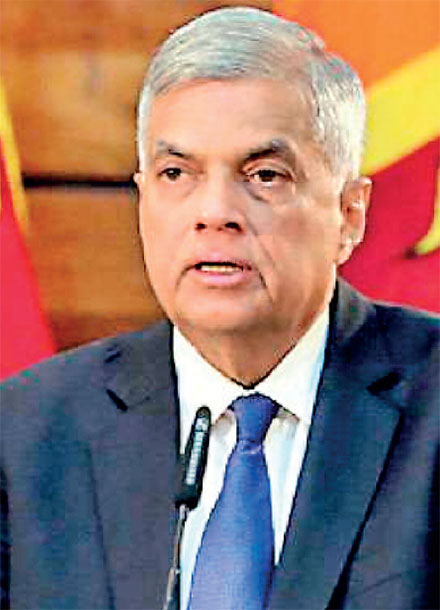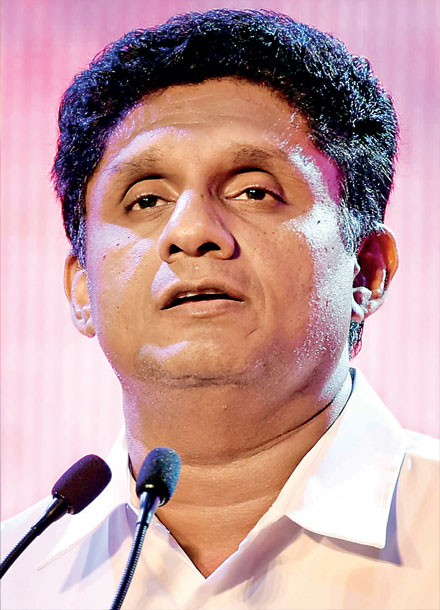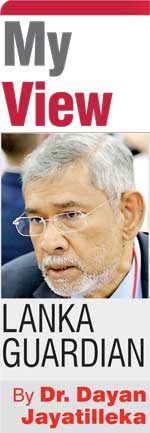Wednesday Dec 17, 2025
Wednesday Dec 17, 2025
Thursday, 11 August 2022 00:45 - - {{hitsCtrl.values.hits}}

President Ranil Wickremesinghe

Opposition Leader Sajith Premadasa
“…Perhaps, this is the first time in South Asia, a largely peaceful peoples protest has succeeded in forcing a leadership change…”
(Col. R. Hariharan, https://col.hariharan.info/2022/08/sri-lanka-wickremesinghe-in.html)
|
 The above quote from Col. Hariharan, hardnosed former Head of Intelligence of the IPKF (1987-1990), should establish the exceptionality, even regional uniqueness, of the Aragalaya.
The above quote from Col. Hariharan, hardnosed former Head of Intelligence of the IPKF (1987-1990), should establish the exceptionality, even regional uniqueness, of the Aragalaya.
There was a clear win/win scenario, a story which could have gained Sri Lanka the international support we needed and a government the domestic support it needed. The Aragalaya, the historic peaceful people’s uprising that gouged out President Gotabaya Rajapaksa who wrecked the economy, should have been crowned with free elections to Parliament and the Presidency, completing a classic anti-autocracy democratic revolution, and securing the international goodwill that would have been the soft power to leverage the most generous program for debt restructuring and recovery.
International opinion would have applauded that narrative closure, and the global players would have known that the island had freely elected, popular leaders with the public consent to make any agreements stick.
Instead, the prospect has darkened, with Aragalaya activists being rounded-up and an utterly unelected leader handpicked by the since-deposed President, selected as President by a Parliament dominated by the Rajapaksas’ pets in the ruling party.
By what moral right is the unelected Wickremesinghe administration arresting and prosecuting the leading activists of this regionally exceptional emancipatory struggle?
The Opposition should have refused to attend the discussions with President Wickremesinghe until the repression was stopped and reversed (except in the cases such as those of the Nittambuwa killings and the attempted killing of Kumar Welgama).
The Constitution founded on popular sovereignty is predicated on the conferment of a plenitude of power on the President, preponderating over the Prime Minister, Cabinet and Parliament, on the basis that he/she is elected by a majority of the citizenry of the country taken as a whole. President Ranil Wickremesinghe is not popularly elected even by the voters of Colombo and as such is not entitled to the power he wields; certainly not the powers of the 20th Amendment, which were regarded by the public as wholly excessive even in the case of Gotabaya Rajapaksa who had been popularly elected to the presidency.
Therefore, the degree of structural asymmetry that currently prevails between President Wickremesinghe and the parliamentary parties that attend the roundtable discussions with him, has no basis in legitimacy.
The playing field should be levelled or at least made much less uneven than it currently is, by means of the 22nd Amendment Plus. The Opposition should have insisted on that as a condition for any discussion. It still can.
Establishment exposed
There are two vital shifts, degenerative displacements, one which has taken place, and another which is sought by President Wickremesinghe.
The first, which has taken place and is still doing so before our eyes, is in the moral and ethical domain.
The second which has begun but has not yet been taken to completion, is in the political or politico-systemic domain.
The first is a moral-ethical collapse. On TV News, as in a Netflix crime flick, dozens of photographs appear circled with marker-pens, of perpetrators caught in their criminal acts, such as the act of sitting around the table in occupied state buildings, engaging in spontaneous political theatre, imitating a Cabinet meeting packed with Rajapaksas, satirising the former ruling clan—hilarious political satire we’d pay good money to watch if it were Puswedilla.
We, the citizens, are asked to inform on these playful, yet committed youngsters who fought with no weapons except for their will-power and wit, for the liberation of our society from the rule of a clan helmed by an irrational president who wrecked our peasant agriculture and food supply.
The young man who was the first up the steps and in effect led the emancipatory wave into the Presidential Secretariat on 9 July, walked into the police station to give a statement and has been arrested. The National Organiser of the FSP’s student wing was abducted.
We’ve been here before. In 1972, dozens of Tamil youth were jailed for hoisting black flags in protest against a new Constitution which had enthroned Sinhala and Buddhism in a hegemonic position as the Soulbury Constitution had not at Independence in 1948. When these youth were released years later, the lesson of their incarceration had been drawn by their generation and the mode had shifted to armed struggle, opening the thirty years war.
The second shift is initiated by President Wickremesinghe and seeks to build an all/multi-party coalition around himself. If he succeeds, the political establishment will be exposed before the public as a single political elite with many political parties –like the many snakes (hissing at each other) all sprouting from Medusa’s head.
Today, the parliamentary political parties sit around a table with the President who has permitted this repression of the Aragalaya activists, pleading politely against the crackdown while discussing “joining forces” in an “all/multi parties governance” arrangement. These parties and personalities sound like a single parent promising to enter a trial re-marriage with someone they separated from, provided he stops beating the kids. More clinically, they sound like they are suffering from political ‘multiple personality disorder’.
Ranil’s wrong reading
While calling on a senior monk, Ven. Ittepane Dhammalankara, President Wickremesinghe engaged in “musaavaadaya” (untruth). He told the respected monk that if all parties did not unite at this time in a pluri-party governance arrangement and program, what was at risk of destruction was the Constitution and democracy itself. The truth is the very opposite.
Sri Lanka’s (and earlier, Ceylon’s) democracy had such resilience and longevity, surviving civil wars of the sort which ended in so many other countries, mostly but not only of the global South, either in a military coup or less frequently, revolutions, precisely because we had a robust, two-party competitive democracy, with frequent alternation in government. When a crisis or war is mishandled by one party or coalition, the voters switched to the other mainstream option and got the job done.
On the one occasion that scheduled parliamentary elections were postponed by a fraudulent, coercive plebiscite in the ostensible interest of stability and continuity for the purpose of rapid economic development, we had two civil wars, South and North.
Contrary to President Wickremesinghe’s assertion, Constitutional democracy is best served not by an all-parties arrangement but precisely by its opposite. Furthermore, Constitutional democracy is most seriously threatened by the suspension of the competitive two-party/multi-party system and lining up all parties like ducks in a row or eggs in a basket.
The most recent experience in a bipartisan government, which is the core of the all/multiparty formula, was the Yahapalanaya administration of 2015-2019. The two components were the UNP of Ranil Wickremesinghe and the SLFP of Maithripala Sirisena, with the latter as President. When that experiment ended, the UNP had been wiped out electorally, the SLFP had been shattered and a new Sinhala nationalist-populist party, the SLPP, had swept to power. The victorious Gotabaya candidacy was the child of the Yahapalanaya experiment in bipartisan cohabitation. Cluster cohabitation will spawn a worse monstrosity.
The UNP didn’t go electorally extinct because the SJB broke away. The undivided UNP as well as the SLFP faction holding office and led by President Sirisena, had been beaten convincingly at the Local Authorities election of February 2018 by the new-born SLPP.
By breaking away under Sajith Premadasa’s leadership, the SJB constituted a lifeboat for the UNPers who would otherwise have gone down with the ship in August 2020. Now, President Wickremesinghe and a rightwing faction of the SJB (“we share President RW’s economic philosophy”), want the SJB lifeboat to be hauled back on board the Titanic or towed by the Titanic under the same skipper.
Economic Batalanda
The Lite version of the ‘all/multi party governance’ formula is an ‘all-party national plan’ and an ‘all-parties National Council’. Whatever ‘national plan’ subscribed to will merely be camouflage for a harsh economic austerity and public-spending slashing program, a precursor of which is the 75% electricity price-hike. To a public in pain, the participants in the so-called national program, National Council and ‘all/multi-party governance’ will all look alike: shareholders of the Establishment. The Enemy.
Starting with the mid-1980s uprising of the urban poor against Chile’s tough Pinochet dictatorship, an abortive assassination attempt, defeat at a referendum and presidential election, it is almost impossible to point to any administration anywhere in the world in the past 35 years, that implemented an economic austerity program in a downturn and survived.
The alternative that the public turns to will be the party/parties that stayed out of these ‘all-parties/multi-party’ structures and arrangements under President Ranil Wickremesinghe; the party/parties that did not sell-out; that opposed an economic Batalanda and proffered a less sadistic, more humane alternative.
With the SJB stridently protesting over the dowry (‘end repression, interim/short-term, early elections’) while coyly entertaining the (re)marriage proposal, it looks like the electoral default option will be AKD’s JVP-NPP.
|
Hath Howler
Ceylon once had an officially-designated “National Government” in 1965-1970, led by Prime Minister Dudley Senanayake and his UNP. This was a 7-party coalition cobbled together by Esmond Wickremesinghe, which the public referred to rudely as “Hath Havula” (“the 7 cluster”).
My father, Mervyn de Silva sounded a warning not only in his newspaper articles, but with a large map of Ceylon on which he used coloured pencil to shade in the political opinion preferences he had ascertained after observing political events in provincial towns (visits on which I accompanied him), with probable percentages marked against each province. He presented it to Ranjit Wijewardena, the youthful yet distinguished, discerning Chairman of Lake House, who took Mervyn’s prognosis seriously enough to apply for a licensed revolver. Ranil Wickremesinghe’s parents Esmond and Nalini, the most powerful members of the Lake House Board of Directors, brushed Mervyn’s projections aside with typically myopic arrogance.
That 7-party ‘National Government’ ended with a three-party ‘blue-red’ Opposition coalition of the centre-left clocking the first ever two-thirds majority in the island’s parliamentary history (with downstream disaster).
At my father’s side, a podgy 13+, I ascended the Lake House steps on the morning the results of General Election 1970 came in, Mervyn sporting a short-sleeved blue shirt with red circles (or the other way around). Ten days later, his long-deferred promotion as Editor Daily News, held back for years and conferred on someone junior to him by the Wickremesinghe duo on ideological-political grounds, came through. Writing in the New Left Review, Isaac Deutscher’s widow Tamara drily observed that “the flagship of the establishment, the staid Ceylon Daily News, reshuffled its editorial staff and paraded pink camouflage”.
President Ranil Wickremesinghe’s “all/multi-party government/governance” slogan merely echoes his father’s. Any coalition arrangement under him is likely to fare much worse.
|
Opposition leader’s options
President Ranil Wickremesinghe is using a paternal template. So should Opposition and SJB leader Sajith Premadasa.
The current crisis is tailor-made for the Sajith Premadasa of November 2019. Were Sajith to return to the robust ‘[Ranasinghe] Premadasaist’ populism of his Presidential candidacy, even if a small group of rightwing SJB MPs were to defect to Ranil, they would take only a couple of hundred thousand votes with them. On the other hand, if the SJB were to be seen as part of a Ranil-led bloc of economic camp-followers, the party’s loss of actual and potential voters could run into millions.
The SJB’s loss would be the JVP’s gain. Having served twice as the Leader of the Opposition, Dr. N.M. Perera, head of the LSSP, the largest party in the Trotskyist 4th International, would most certainly have been elected Prime Minister of Ceylon at the 1956 General election—after the Hartal of August 1953—had S.W.R.D. Bandaranaike and the SLFP not been the centre-left alternative to Sir John Kotelawala’s UNP.
While the present economic crisis is unprecedented in its severity, there was a precursor and prototype in the 1970s. In the first half of the decade, the system had been hit by double shocks, firstly the youth revolt of 1971, secondly the OPEC oil price hike of 1973.
In 1972 J.R. Jayewardene offered his support to the government of the day, urged the adoption of a presidential system, suggested a National Government and even signalled his willingness to join the government as it existed, though resistance from its left coalition partners aborted the idea.
Sajith’s father R. Premadasa’s response was the polar opposite. He launched a trenchant critique of the UNP in an exchange of letters with party leader Dudley Senanayake (published by Mervyn de Silva in the Ceylon Daily News). Premadasa went on to form the Citizens’ Front (Samastha Lanka Puravesi Peramuna) which held public rallies in several parts of the island including at Hyde Park, Colombo. Empathetic to the youth rebellion, he attended every single sitting of the Criminal Justice Commission trial, the trial of the JVP insurrectionists led by Rohana Wijeweera.
Premadasa rolled-out a radically new, progressive economic project to exit the crisis in a speech to the Rotary Club of Colombo West on 4 April 1973. He was to republish in it the Ceylon Daily News in 1991, underscoring the consistency of his policy paradigm from his years as lone-wolf Opposition MP to the country’s elected President and Chairman of SAARC.
Actively returning to the UNP after as Deputy Leader in 1973 under the leadership of J.R. Jayewardene following the death of Dudley Senanayake, he dissolved the Citizens’ Front but ensured that the UNP was transformed along the socially representative lines he had urged in his internal polemic of 1972-’73.
In the Opposition of 1973-1977, none was more uncompromising and savagely slashing towards the governing coalition than R. Premadasa. Caught in the Opec oil price hike and hard-cash crunch, had the ruling Coalition Government hiked the price of electricity overnight by 75%, Premadasa would have organised a massive campaign of satyagraha, peaceful civic disobedience, hammering home that poor and middle-class families would be most affected even in terms of their children’s study-time and modicum of leisure, while enterprises would be hit by skyrocketing production costs. Premadasa would spurn collaborationism, rejecting ideas of joining forces in a national plan, national council or all/multi-parties governance arrangement.
Having worked with President Premadasa during all but the first weeks of his presidency, I recall a favourite Sinhala phrase of this developmental-managerial maestro, pertaining to the division of labour: “The dog must not do the donkey’s work, and the donkey must not do the dog’s work.”
Applying that to the current context while recollecting Premadasa’s strategy during the 1970s economic crisis, I’d say the job of the Opposition SJB is to be the watchdog of the people’s living standards and interests, while the job of the Wickremesinghe administration is that of the donkey bearing the burden of managing the crisis.
If Sajith Premadasa and the SJB attempt to combine the job descriptions of the dog and the donkey, they will perform neither, certainly not to the satisfaction of a majority of voters.